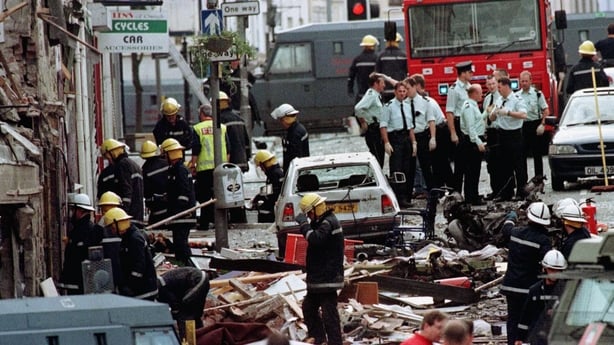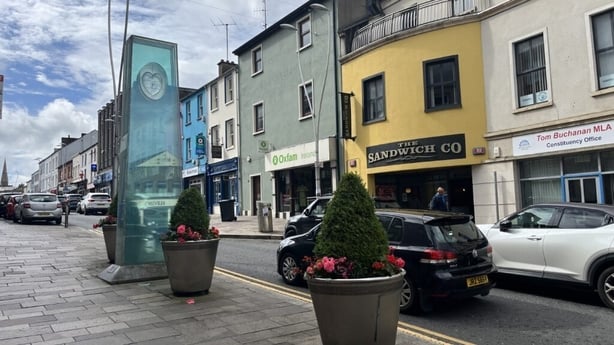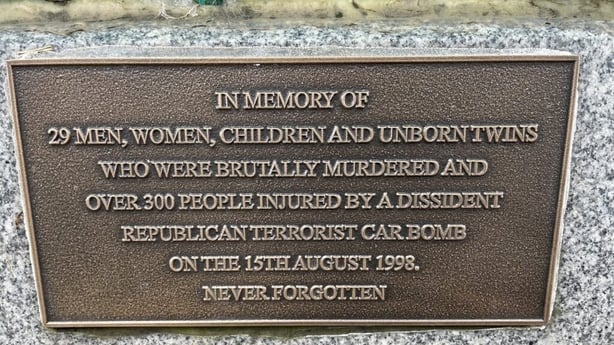A glass memorial plinth marks the spot where dissident republicans left a car bomb in Omagh, Co Tyrone, 25 years ago.
At 3.10pm on 15 August 1998, the Real IRA device exploded sowing carnage amongst the Saturday shoppers.
The bombers had driven it across the border and into position earlier in the day.
A botched bomb warning gave the wrong location.
It meant that rather than being shepherded away from danger, police clearing the streets sent the public towards it.
Scores of people were milling around the car bomb at the bottom of Market Street when it went off.
Thirty-one lives were lost that day, including two unborn babies in their mother's womb.
Three generations of that same family were killed.
Men, women and children all died.
The victims were from Omagh, its surrounding villages, Donegal and Spain.
A group of children from Buncrana, Co Donegal, had travelled to Omagh on a day trip.

Some of the group were Spanish exchange students who were staying with families from Buncrana.
Chance was all that separated the dead and injured from those who escaped physically unscathed.
Monica Taggart from Fintona, Co Tyrone, was a case in point.
She was 18 years old and had earned £30 singing at a wedding earlier that day and had come into town to spend it.
She was unconcerned by the security alert, which was a common occurrence back then.
She spotted a friend across the street and waved. As her friend stepped off the kerb to cross and greet her, the bomb went off.
Ms Taggart was only metres from the bomb but a woman was blown into her, protecting her from serious injury.
She did not lose consciousness and has a vivid recall of what she saw and heard as she lay in the rubble.
It has haunted her to this day, affecting every aspect of her life.

"One of the biggest things for me is actually survivor's guilt. I still have such a sense of survivor's guilt that it should have been me and not the wee young children from Buncrana that lost their lives that day.
"But unfortunately there's nothing I can do about that, but it does eat me up," she says, her voice breaking, tears trickling down her cheek.
The atrocity was the biggest loss of human life in any single incident of the Troubles in Northern Ireland.
It was shocking, not just for the loss of so many lives, but because at the time, the talk was of peace.
The main loyalist and republican paramilitary groups had called ceasefires, the Good Friday Agreement had been negotiated and endorsed in referenda on both sides of the border.
But dissident republicans were waging a concerted bombing campaign in towns across Northern Ireland in an attempt to shatter the fragile peace.
The bombing in Omagh put an end to that.
A number of people were brought before the courts, but in the end, no one was held criminally culpable.
A successful civil action by the families saw four men held liable for causing the explosion.
Several of the chief suspects are now dead.
The case has been dogged by allegations that in trying to protect informants, the bomb may have inadvertently slipped through the security net.
The British government has agreed to hold a public inquiry. The Irish Government is deciding how it will help establish the fullest possible picture of what happened.
For the bereaved and the injured, the consequences of that terrible day continue to reverberate.

The friend Ms Taggart was waiting to greet that sunny Saturday was killed in the blast.
She feels like a hidden casualty, physically unhurt but bearing deep emotional scars.
Sudden noises, certain smells and catching sight of someone she recognises from that terrible day are all triggers that bring her back to the rubble of Market Street.
Saddled with post-traumatic stress disorder and anxiety, she considers herself unworthy of being described as a victim of the Omagh bombing, when so many others suffered so grievously.
But every day she has her own demons to face.
"Make-up is my mask, I won't come out of the house without it since the day of the bomb. With my make-up on and a smile, everybody thinks I'm alright.
"But deep down I know myself the trauma I've been through. It has been horrific and it has totally changed my life."






